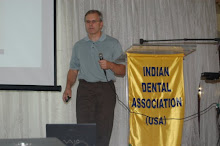I often receive questions on space closure mechanics; I will take this opportunity to address issues regarding space closure.
First, and most important, the biology of tooth movement is more important in determining the rate of space closure than the particular technique used. Osteoclasts and osteoblasts must do their job; human premolar and molar roots can move bodily through bone at the rate of about 1mm per month. In most cases, movement faster than this amount means teeth are tipping into the extraction site. This type of movement is usually counter-productive.
Second, the arch must be completely leveled before space closure can occur. That means the practitioner must leave the working wires (usually .019x.025 st.steel in a .022 slot) in the arch passively for at least a month. Once the arch is leveled, space closure can commence.
Third, many practitioners inform me they prefer to close space on a round working wire (most commonly .020 st. steel in a .022 slot). They claim that friction due to the rectangular wire filling the slot inhibits space closure. I believe this is false. Closing space on round wire is usually not indicated for the following reasons:
1) Loss of torque control. Torque is the weak link of the pre-adjusted appliance. Closing space without torque control uprights anterior teeth. This gives the completed extraction case a “rabbitted” appearance- the teeth end up too upright. This is especially problematic in upper bicuspid extraction cases, as the uprighted maxillary anteriors can occlusally interfere with the lower anteriors.
2) Speed of space closure. The rate of ostoblastic and osteoclastic activity, not the amount of friction, determines the speed of space closure. (1) Controlled force levels on a rigid wire eliminate nearly all of the potentially deleterious side-effects associated with space closure mechanics. Remember, if the rate of space closure exceeds 1mm per month, the teeth are probably tipping into the extraction site. This is detrimental to the orthodontic result.
Fourth, many practitioners ask what is the best force system to use. Many systems work well, as the big issue is to provide adequate amounts of force after the arch has been leveled. I prefer en-masse space closure (moving the 6 anterior teeth as 1 unit) to canine retraction. En-masse closure takes full advantage of the principle of sliding mechanics, which is one of the big advantages of the pre-adjusted appliance. As for force application, many effective methods exist. Nitinol coil springs or active tie-backs are very effective. However, I like to use elastics. The proper force is usually provided by ¼" medium Class I elastics when the exraction site is larger than 4mm.When the site is 2-4 mm wide, switch to 3/16" medium. For the last mm or 2 of space closure, use chain elastic. My patients wear the elastics full time and change them every 12 hours. They attach the elastic from the hook on the canine bracket to the hook on the last bracketed molar. The anterior 6 teeth are held together (as 1 unit) by chain elastic or a figure-8 steel ligature tie.

src="http://pagead2.googlesyndication.com/pagead/show_ads.js">
Using elastics to close space provides the practitioner the flexibility to deal with many situations that arise during space closure. For example, if the molars are a little Class II, space closure can be accomplished by applying the elastics in a Class II direction. In fact, the practitioner can apply the elastics in virtually any configuration to close the space in the manner required in the individual case.

Delays in space closure
A couple of reasons exist which can cause delays. Often, upper premolar brackets are placed too gingivally. This results in over eruption of the premolars, resulting in occlusal interferences. Also, gingival tissue can build up in the extraction site, causing delays. In addition, dented or bent tubes or bracket slots can inhibit sliding. So if the space is not closing appropriately, check these three items. Chances are, you will discover the problem.
Reference
1. Miles PG 2007. Self ligating vs conventional twin brackets during en-masse space closure with sliding mechanics. American Journal of Orthodontics and Dentofacial Orthopedics. 132:223-225

3 comments:
usefull information keep posting
Thank you, I am following you for some time and I am finding your information more and more helpful, as I work.
hello, I don't know if this the right place to ask questions, anyway, I read in one of your posts that using class II elastics causes some side effects. If you already have cleared that up, just tell me where is that post is, so that I can read it. Thank you in advance
Post a Comment